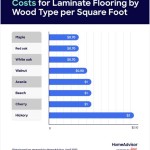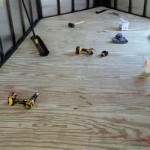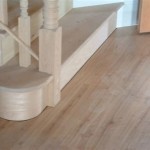Laying Moisture Barrier Laminate Flooring: A Comprehensive Guide
Laminate flooring has become a popular choice for homeowners and businesses alike due to its durability, affordability, and aesthetic versatility. One crucial aspect of a successful laminate flooring installation, particularly in areas prone to moisture, is the inclusion of a moisture barrier. This article delves into the importance of moisture barriers, the types available, the installation process, and factors to consider for optimal performance, providing a comprehensive guide to laying moisture barrier laminate flooring.
Laminate flooring, while generally water-resistant, is not entirely waterproof. The core of laminate flooring is typically made of high-density fiberboard (HDF) or medium-density fiberboard (MDF), which are susceptible to damage from prolonged exposure to moisture. Warping, swelling, and mold growth are potential consequences of inadequate moisture protection. Therefore, a moisture barrier is an essential component, especially in basements, kitchens, bathrooms, laundry rooms, and areas with concrete subfloors.
The purpose of a moisture barrier is to prevent moisture from migrating upwards from the subfloor, protecting the laminate flooring from damage. It acts as a shield, blocking water vapor and liquid spills from penetrating the core of the laminate planks. Choosing the correct type of moisture barrier and installing it properly are critical for ensuring the longevity and performance of the laminate flooring.
Different types of moisture barriers are available, each with unique characteristics and benefits. The selection should be based on the specific project requirements, including the type of subfloor, the level of moisture exposure, and the manufacturer's recommendations for the laminate flooring being installed. Neglecting these considerations can compromise the effectiveness of the moisture barrier and lead to flooring failures down the line.
Understanding the Importance of a Moisture Barrier
The significance of a moisture barrier extends beyond simply preventing surface spills from seeping into the laminate flooring. Subfloors, particularly concrete slabs, often contain inherent moisture. This moisture can evaporate and rise through the subfloor, eventually reaching the underside of the laminate flooring. Over time, this continuous exposure to moisture can cause the laminate core to swell, leading to buckling, warping, and separation of the planks.
Furthermore, trapped moisture can create a breeding ground for mold and mildew. These microorganisms not only damage the flooring material but also pose health risks to occupants. Mold spores can trigger allergic reactions and respiratory problems, making it essential to prevent their growth through proper moisture management.
Inadequate moisture protection can also void the manufacturer's warranty for the laminate flooring. Most warranties require the installation of a moisture barrier according to specific guidelines. Failure to comply with these guidelines can render the warranty invalid, leaving the homeowner responsible for the cost of repairs or replacements due to moisture-related damage.
Therefore, investing in a high-quality moisture barrier and ensuring its proper installation is a preventative measure that safeguards the laminate flooring investment, protects the health of occupants, and preserves the validity of the product warranty.
Types of Moisture Barriers for Laminate Flooring
Several types of moisture barriers are available for laminate flooring installation, each offering varying levels of protection and ease of installation. The most common types include polyethylene film, foam underlayment with an attached moisture barrier, and liquid-applied moisture barriers.
Polyethylene film, typically 6-mil thickness or greater, is a cost-effective option for providing a basic level of moisture protection. It is installed as a separate layer between the subfloor and the laminate flooring. The film should be overlapped at the seams and taped securely to create a continuous barrier.
Foam underlayment with an attached moisture barrier combines cushioning and moisture protection in a single product. This type of underlayment is convenient to install and provides added sound insulation. The moisture barrier is typically a thin layer of polyethylene or other waterproof material adhered to the foam.
Liquid-applied moisture barriers are designed for concrete subfloors with high moisture content. These barriers are applied as a coating to the subfloor, creating a seamless and impermeable layer. They are particularly useful in basements and other areas where moisture is a significant concern.
The choice of moisture barrier should be based on the specific project requirements, including the type of subfloor, the level of moisture exposure, and the manufacturer's recommendations for the laminate flooring being installed. Consulting with a flooring professional can help determine the most suitable option for a particular application.
Installation Process: Laying a Moisture Barrier
Proper installation of the moisture barrier is crucial for its effectiveness. The installation process typically involves the following steps:
1. Subfloor Preparation: The subfloor should be clean, level, and dry before installing the moisture barrier. Remove any debris, nails, or screws that could puncture the barrier. Repair any cracks or imperfections in the subfloor to ensure a smooth surface.
2. Moisture Testing (for Concrete Subfloors): Before installing any moisture barrier on a concrete subfloor, it is essential to test the moisture content. Several methods can be used, including calcium chloride tests and electronic moisture meters. The results of the moisture test will determine the appropriate type of moisture barrier to use.
3. Unrolling and Overlapping: Unroll the moisture barrier material across the subfloor, overlapping the edges by the manufacturer's recommended amount (typically 6-12 inches). This overlap ensures that there are no gaps where moisture can penetrate.
4. Taping the Seams: Secure the overlapping seams with moisture-resistant tape designed for this purpose. Press the tape firmly to create a tight seal. For polyethylene film, use a wide, durable polyethylene tape. For underlayment with attached moisture barrier, use the manufacturer's recommended tape or adhesive.
5. Sealing Around Obstacles: Carefully cut and seal the moisture barrier around pipes, posts, and other obstacles. Use tape or sealant to create a watertight seal. Pay particular attention to details to prevent moisture from entering through these vulnerable areas.
6. Installing the Laminate Flooring: Once the moisture barrier is properly installed, you can begin laying the laminate flooring according to the manufacturer's instructions. Ensure that the laminate planks are properly aligned and locked together to create a seamless surface.
Following these steps carefully will help ensure that the moisture barrier provides effective protection for the laminate flooring, preventing moisture-related damage and extending the life of the flooring.
Ensuring proper subfloor leveling is critical, and self-leveling compounds might be required in certain situations. Understanding the proper techniques for acclimating laminate flooring prior to installation will also impact the longevity of the floor itself in combination with the moisture barrier. Neglecting acclimation can lead to expansion and contraction issues and potential damage, regardless of the effectiveness of the moisture barrier.
Maintenance of the laminate flooring after installation is important for its longevity. Regular cleaning with appropriate products and prompt attention to spills will help prevent moisture from penetrating the surface and damaging the core. Avoid using excessive water when cleaning the floor, and never allow water to pool on the surface.
Specific laminate products may require specific installation instructions. Always refer to the manufacturer's guidelines for both the laminate floor and the moisture barrier underlayment to prevent installation errors. This process may include adhering to specific room temperatures and humidity readings to assist in acclimation and prevent installation errors.

What Is A Moisture Barrier And When It Needed For Flooring Inc

What Is A Moisture Barrier And When It Needed For Flooring Inc

How To Install The Moisture Barrier Over Concrete Subfloor

Vapor Barrier Under Laminate Floor And Floating Problems

Does The Quiet Walk Underlayment Plastic Vapor Barrier Face Up Or Down When Installing Mp Global S Llc

6 Mil Vapor Barrier Underlayment Over Concrete Floors

What Is A Moisture Barrier And When It Needed For Flooring Inc
Minimizing Moisture From Subflooring Kaltimber Timber Merchant Flooring

Installing Laminate Flooring For The First Time Crafted Work

3 Sources Of Moisture That Can Damage Your Laminate Flooring
Related Posts








